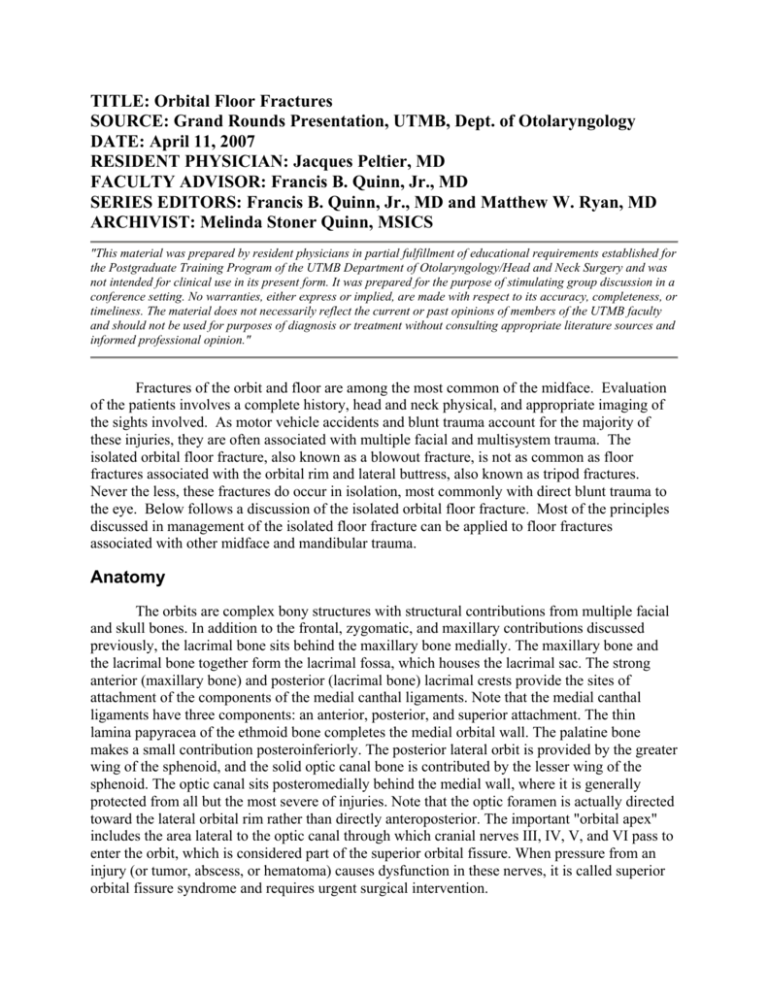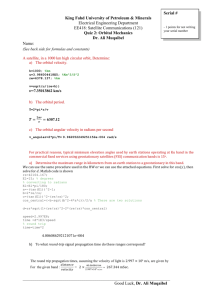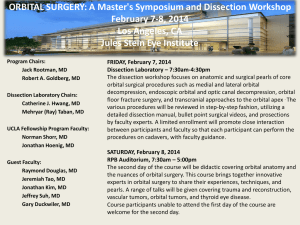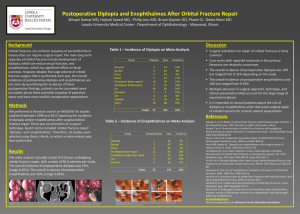TITLE: Orbital Floor Fractures SOURCE: Grand Rounds
advertisement

TITLE: Orbital Floor Fractures SOURCE: Grand Rounds Presentation, UTMB, Dept. of Otolaryngology DATE: April 11, 2007 RESIDENT PHYSICIAN: Jacques Peltier, MD FACULTY ADVISOR: Francis B. Quinn, Jr., MD SERIES EDITORS: Francis B. Quinn, Jr., MD and Matthew W. Ryan, MD ARCHIVIST: Melinda Stoner Quinn, MSICS "This material was prepared by resident physicians in partial fulfillment of educational requirements established for the Postgraduate Training Program of the UTMB Department of Otolaryngology/Head and Neck Surgery and was not intended for clinical use in its present form. It was prepared for the purpose of stimulating group discussion in a conference setting. No warranties, either express or implied, are made with respect to its accuracy, completeness, or timeliness. The material does not necessarily reflect the current or past opinions of members of the UTMB faculty and should not be used for purposes of diagnosis or treatment without consulting appropriate literature sources and informed professional opinion." Fractures of the orbit and floor are among the most common of the midface. Evaluation of the patients involves a complete history, head and neck physical, and appropriate imaging of the sights involved. As motor vehicle accidents and blunt trauma account for the majority of these injuries, they are often associated with multiple facial and multisystem trauma. The isolated orbital floor fracture, also known as a blowout fracture, is not as common as floor fractures associated with the orbital rim and lateral buttress, also known as tripod fractures. Never the less, these fractures do occur in isolation, most commonly with direct blunt trauma to the eye. Below follows a discussion of the isolated orbital floor fracture. Most of the principles discussed in management of the isolated floor fracture can be applied to floor fractures associated with other midface and mandibular trauma. Anatomy The orbits are complex bony structures with structural contributions from multiple facial and skull bones. In addition to the frontal, zygomatic, and maxillary contributions discussed previously, the lacrimal bone sits behind the maxillary bone medially. The maxillary bone and the lacrimal bone together form the lacrimal fossa, which houses the lacrimal sac. The strong anterior (maxillary bone) and posterior (lacrimal bone) lacrimal crests provide the sites of attachment of the components of the medial canthal ligaments. Note that the medial canthal ligaments have three components: an anterior, posterior, and superior attachment. The thin lamina papyracea of the ethmoid bone completes the medial orbital wall. The palatine bone makes a small contribution posteroinferiorly. The posterior lateral orbit is provided by the greater wing of the sphenoid, and the solid optic canal bone is contributed by the lesser wing of the sphenoid. The optic canal sits posteromedially behind the medial wall, where it is generally protected from all but the most severe of injuries. Note that the optic foramen is actually directed toward the lateral orbital rim rather than directly anteroposterior. The important "orbital apex" includes the area lateral to the optic canal through which cranial nerves III, IV, V, and VI pass to enter the orbit, which is considered part of the superior orbital fissure. When pressure from an injury (or tumor, abscess, or hematoma) causes dysfunction in these nerves, it is called superior orbital fissure syndrome and requires urgent surgical intervention. It is important to remember the shape of the orbit before attempting repair of the floor. Repairing the orbital walls and recreating the orbital volume is necessary to allow repositioning of the globe into its normal anatomical position. As such, it is important to remember that the floor is concave inferolaterally and tends to be more convex medially and becomes significantly convex posteriorly behind the equator of the globe. Important in the design of the orbit is its inherent ability to protect vital structures by allowing fractures to occur. Because the globe is surrounded by fat and the medial wall and floor of the orbit are thin, force that is transmitted to the globe allows fracture of the orbit without significant globe injury. This accounts for the significantly higher incidence of fractures of the orbit as compared to open globe injuries. History and Physical Most patients present after facial trauma and may describe decreased visual acuity, blepharoptosis, binocular vertical or oblique diplopia (especially in upgaze), and ipsilateral hypesthesia, dysesthesia, or hyperalgesia in the distribution of the infraorbital nerve. Nausea and vomiting are important points of the history to elicit. In one study, 83% of children with trapdoor fractures and nausea and vomiting were found to have entrapment of the inferior rectus muscle on intraoperative exam. In addition, some patients may complain of eyelid swelling following nose blowing, as well as epistaxis. Periorbital ecchymosis and edema accompanied by pain are obvious external signs and symptoms, respectively. Enophthalmos may be discerned, but initially it can be obscured by surrounding tissue swelling. This swelling also may restrict extraocular muscle motility, giving the impression of entrapment within the floor defect. Proptosis may result from retrobulbar or peribulbar hemorrhage. Palpation of the orbit may reveal point tenderness as well as a bony step-off of the orbital rim. Examination of the globe is essential and may be difficult secondary to soft tissue edema. Pupillary dysfunction, if present, coupled with decreased visual acuity should alert to the possibility of a traumatic optic neuropathy. Ocular misalignment, hypotropia or hypertropia, and limitation of elevation in the affected eye that is not found to the same degree in the contralateral eye can be present. Forced duction tests aid in differentiating entrapment from neuromyogenic etiology. The supratarsal crease may deepen along with narrowing of the palpebral fissure as a result of enophthalmos or fibrous tissue contraction. Although the palpebral fissure may in fact narrow, the geometric shape is preserved since dehiscence or disruption of the canthal tendons is uncommon. Treatment Indications for repair of orbital blowout fractures include diplopia that persists beyond 7 to 10 days, obvious signs of entrapment, relative enophthalmos greater than 2mm, fracture that involves greater than 50% of the orbital floor (most of these will lead to significant enophthalmos when the edema resolves). The only urgent indication for repair is entrapment that causes an oculocardiac reflex with resultant bradycardia and cardiovascular instability. The timing of repair is debated. Most agree that if operative intervention is not undertaken in the first 24 hours, it should be delayed 10 days to let the edema resolve. Fracture repair should be undertaken prior to 14 days to prevent scarring of floor contents to the bone fragments and contents of the maxillary sinus. A Metaanalysis was performed by Michael Burnstine in 2000 in which he reviewed the available literature to evaluate the best timing for repair of floor fractures. The following were his recommendations: Immediate repair should be performed if (1) diplopia is present with CT evidence of an entrapped muscle or periorbital tissue associated with nonresolving oculocardiac reflex: (2) bradycardia, heart block, nausea, vomiting, or syncope, or for “White-eyed blow-out fractures” in young patients (less than 18 years old), with a history of periocular trauma, little ecchymosis or edema, marked extraocular motility vertical restriction, and CT examination revealing an orbital floor fracture with entrapped muscle or perimuscular soft tissue, or (3)if there is early enophthalmos/hypoglobus causing facial asymmetry. Repair should be performed within 2 weeks for symptomatic diplopia with positive forced ductions, evidence of an entrapped muscle or perimuscular soft tissue on CT examination, and minimal clinical improvement over time, or a large floor fracture causing latent enophthalmos or significant hypo-ophthalmos, or progressive infraorbital hypoesthesia. Observation was recommended for minimal diplopia (not in primary or downgaze), good ocular motility, and no significant enophthalmos or hypo-ophthalmos.(1) Multiple surgical approaches have been described to gain access to the surgical floor. The three most common are the transconjunctival, subciliary, and subtarsal. The transconjunctival approach allows for good access to the floor, gives no visible scars, and has a very low incidence of scleral show or entropion. The disadvantages are the potential for corneal abrasion and lack of exposure if a lateral canthotomy and cantholysis is not performed. The subciliary incision is made just below the lash line and dissection is performed underneath the tarsus, dividing the obicularis muscle from the orbital septum and following the septum to the floor of the orbit. This gives good access to the floor and gives camouflage to the scar. Several studies have shown a high incidence of scleral show and ectropion with this approach, and it is generally agreed that this approach has the highest risk of these two complications. The subtarsal approach is performed with an incision right down to the orbital rim. It gives the best exposure but can be associated with a high rate of plate exposure and prolonged lid edema. The transconjuctival approach is started with a lateral canthotomy and lysis of the inferior limb of the lateral canthal tendon. The incision is made through the conjunctiva and the fusion of the lower lid retractors and orbital septum just below the tarsus. 5-0 silk sutures are used for traction to aid with dissection to the orbital rim. At the level of the arcus marginalis, the orbital septum fuses with the periosteum. This is the point at which the periosteum is opened with a 15 blade. Regardless of the approach, from this point the procedure is the same. Dissection is carefully done from this point with a malleable and an elevator. Care is taken to not retract the globe or the optic nerve to forcefully as this can cause blindness. When the contents of the floor are removed from the maxillary sinus, support in the form of autogenous or synthetic plates are placed in the defect to prevent regress of contents into the maxillary sinus. Alternatively, a Foley type catheter can be placed through the maxillary antrum to support the contents of the orbit until scarring occurs. All incisions are closed. Conjunctival incisions can be closed with 6-0 Catgut or left open to heal on their own. Artificial tears and antibiotics are used in the post-operative period. Vision is tested in the recovery room and monitored over the next day. Any change in vision should be evaluated by an ophthalmologist. Complications Complications of repair are blindness, orbital hematoma, infection of hardware, migration of hardware, entropion, endophthalmos, and diplopia. Orbital hematoma should be promptly treated with lateral cantholysis and canthotomy followed by evacuation of the hematoma in the operative suite. Blindness can be avoided by knowing well the anatomy of the orbit and taking care not to place implants deeper than 4 cm from the lacrimal crest as the optic nerve is located in this area. References 1) Clinical Recommendations for Repair of Isolated Orbital Floor Fractures, An Evidencebased Analysis, Michael A Burnstine, MD, Ophthalmology 2002; 109: 1207-1210. 2) Cummings: Otolaryngology Head and Neck Surgery 4th ed. Chapter 26, Maxillofacial Trauma, Robert M. Kellman, Mobsy, Inc. 2005. 3) Buckling and Hydraulic Mechanisms in orbital Blowout Fractures: Fact or Fiction?, Ahmad et al, Journal of Craniofacial surgery, vol 17, 438-441 4) The Effect of Striking Angle on the Buckling Mechanism in Blowout Fracture, Nagasao et al, Journal of Plastic and Reconstructive Surgery, Vol 117, number 7, March 05









